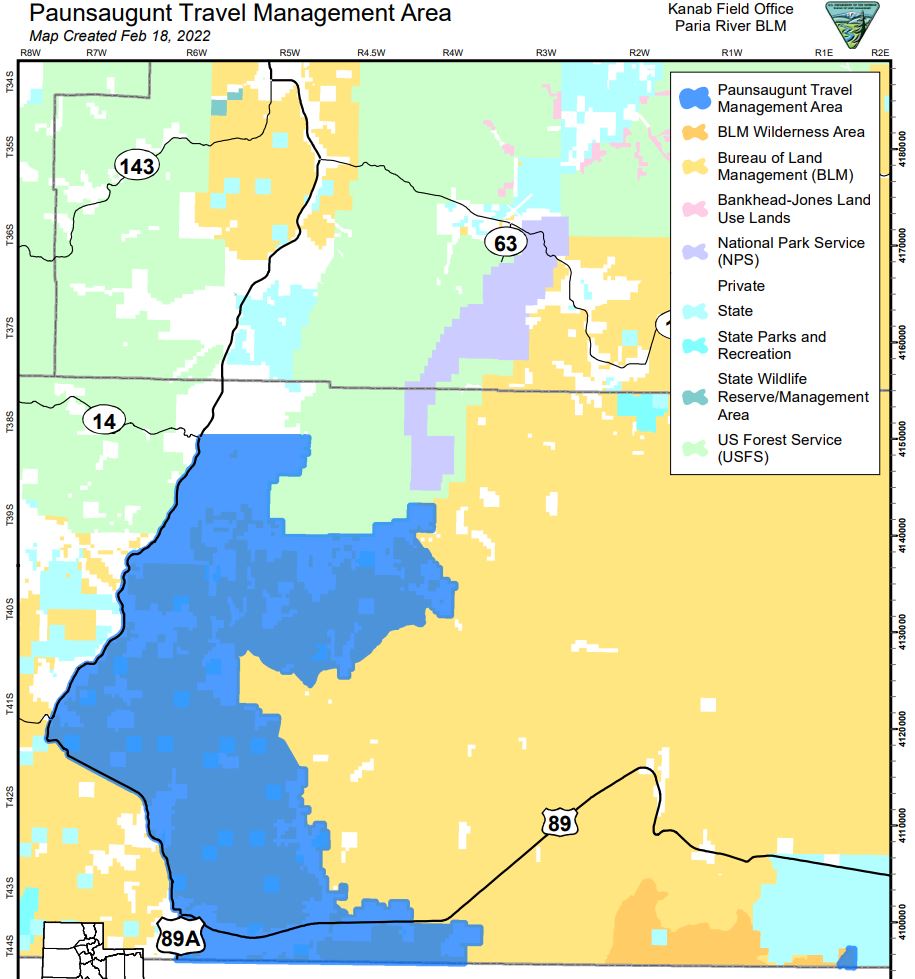Save Access to Kanab Area Trails like Hog Canyon and Peekaboo Canyon
Save Access to Kanab Area Trails like Hog Canyon, Peekaboo Canyon and Johnson Valley Petroglyphs
The Bureau of Land Management has opened scoping of the Travel Management Plan (TPM) for OHV trails in the Paunsaugunt Travel Management Area, which includes many popular trails in the Kanab area such as Hog Canyon and Peekaboo Canyon, as well as the petroglyphs in Johnson Canyon. The area is huge, encompassing everything East of Hwy 89A, South of Hwy 14, and to the Arizona border. It is bordered on the East by other Federal lands not a part of this study. The current TMP has 418 miles of OHV trails, and during the BLM’s internal scoping they identified 33 miles of routes that were overlooked in the 2008 inventory, and are being considered as additions to the OHV inventory, bringing the total to 451 miles of routes being reconsidered for designation. More details on the scoping project can be found here.
not a part of this study. The current TMP has 418 miles of OHV trails, and during the BLM’s internal scoping they identified 33 miles of routes that were overlooked in the 2008 inventory, and are being considered as additions to the OHV inventory, bringing the total to 451 miles of routes being reconsidered for designation. More details on the scoping project can be found here.
The current TMP was done in 2008, and must be reevaluated as a result of a 2017 settlement agreement between the Southern Utah Wilderness Alliance (SUWA) and BLM that stipulated the review of 13 TMPs across Utah. This TMP was one of SUWA’s main focuses of their court filing, and we can expect they will become heavily involved in fighting OHV use in this area. If you have not heard how SUWA and their cooperating agencies feel about OHV use, take a heavy dose of aspirin and visit their website.
The public scoping for this project will consider comments submitted by March 25, 2022. This is our best opportunity to influence the next stage of the process, so your public comments are urgently needed. There are several ways to submit comments, you can choose any of the following methods:
- By completing the form found here and emailing it to blm_ut_kn_mail@blm.gov
- By visiting the Scoping Map found here, clicking on a route (trail) and adding comments.
- By emailing blm_ut_kn_mail@blm.gov
- By Mail sent to: BLM Paria River District, Attn: Pansaugunt TMP, 669 S Hwy 89A, Kanab, UT 84741
So you want to help, but not sure what to say? Here’s some tips about effective comments for this stage of the process.
- The BLM must look at Direct, Indirect and Cumulative Impacts of any change. Direct impacts are those that are caused by the action and occur at the same time and place. Indirect impacts are caused by the action but occur later in time. An example would be that if routes are removed from the inventory, you would have a Direct Impact by immediately losing access to visit that resource, while indirect and cumulativeimpacts could be that remaining routes and resources will be burdened from the increased traffic on them, or that businesses or localities that cater to the OHV community would suffer. All of these are important and must be addressed as valid comments. Further, it is more effective rather than stating an opinion or belief, you ask the BLM to study the impact you have concerns about. For example:
“Please study the effects that could be caused by the closure of routes in this area on remaining resources in the area due to increased traffic or visitation”
“Please study the effects caused by the closure of Johnson Valley OHV routes on people with accessibility issues on visiting and learning about the beautiful petrographs in the area.”
“Please study the effects of closing some of the routes in the area on making quick, easy exits on other trails in the event of medical or other emergencies”
“Please study the impact on emergency access to areas by first responders such as Search and Rescue or Fire crews if trails are not maintained”
- Cite your personal experience with the area. Some possible topics you might include are who you are, how long you’ve been coming to visit, whether you bring your family or other people with you, the amount of money you spend in the community each year when visiting, what types of businesses you frequent (hotels, camping, restaurants, grocery stores, etc).
- If you have done trail maintenance work in the area, please indicate your personal experiences.
- If you have any accessibility issues which would prevent you from continuing to visit if OHV use were disallowed or limited
SUWA will undoubtedly be drumming up their efforts to close as many of these routes as possible. Your action in helping us thwart their attempt is vital, Take Action Today!
